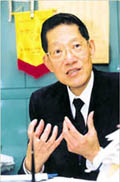
Recognising that small class teaching can serve the needs
of pupils who depend more on individual attention to support their learning,
the AM section of North Point Government Primary School has devised a
way of introducing small class teaching for selected pupils, within the
existing resources. The school has restructured all classes in primary
4, 5 and 6, so that the five classes at each level are re-mixed to form
four bigger classes. From 35 pupils, the size has now increased to around
45 per class. These four classes are further divided into two categories
according to their class results. Two classes are made up of pupils with
a better academic performance while the other two bring together those
with less satisfactory results and are further divided into four small
groups of 20 each. By enlarging the size of the former, teachers are freed
up for small class teaching of pupils who require additional support in
English and maths.
Mr Ho Kwok-suen, headmaster of the school, had carefully
weighed up the possible effects of enlarged classes for some and smaller
classes for others, before proposing the innovation. He saw the larger
classes of better able pupils as providing the school with an opportunity
to enable teachers to help pupils who need further consolidation in order
to develop.
Although it is still too early to evaluate the effectiveness
of this approach, Mr Ho feels that some initial success is evident after
a six month trial. With more individual attention and greater opportunities
for participation, he sees pupils showing enhanced self-esteem and a more
active attitude in their learning. Teachers can monitor the progress of
individual pupils more closely as classroom discipline improves and they
are able to adjust teaching schedules in order to suit the pace and the
needs of particular groups.
Some important lessons can also be learned from the North
Point experience, for those thinking of adopting similar practices.
 |
Mr Ho Kwok-suen tries out small class teaching after careful deliberation |
Staff consensus is essential
Although the plan for small class teaching was finally confirmed only
a few days before the beginning of the new school term in 2002, but Mr
Ho had conceived the scheme many years before and planned it carefully.
He had worked hard to convince his teachers, and after nine months he
finally gained their support.
The teaching and learning approach
and the syllabus content must be carefully tailored
Mr Ho feels that teachers need to adopt a more pupil-oriented mode of
interactive teaching for small classes. They must get to know the pupils
better and tailor their teaching to individual needs.
Devise accurate means of assessment
Small class teaching in the North Point mode depends on a reliable means
of differentiating between better able and less able pupils. There should
also be a means to measure the impact of the approach on the pupils in
the enlarged classes as well as those in the small classes.
Relieve the psychological pressure
on pupils
To minimise labelling effects, Mr Ho has come up with the idea of appointing
"little tutors" from amongst pupils in the small classes. Even
though their class results are less satisfactory compared with their peers,
these pupils blossom when they act as tutors to children of primary 1
and 2. Their self-image is greatly enhanced as a result.
